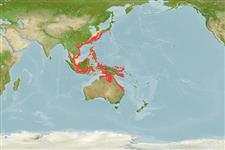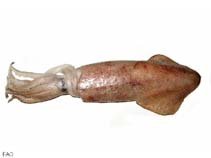Uroteuthis chinensis (Gray, 1849)
Mitre squid| Native range | All suitable habitat | Point map | Year 2050 |

|
| This map was computer-generated and has not yet been reviewed. |
| Uroteuthis chinensis AquaMaps Data sources: GBIF OBIS |
Classification / Names Common names | Synonyms | CoL | ITIS | WoRMS
| Myopsida | Loliginidae
Environment: milieu / climate zone / depth range / distribution range Ecologia
Demersal; não migratória (Ref. 75930); intervalo de profundidade 15 - 170 m (Ref. 275), usually 40 - 150 m (Ref. 75930). Tropical; 21°C - 29°C (Ref. 75934); 34°N - 30°S, 99°E - 154°E (Ref. 275)
Distribuição Países | Áreas FAO | Ecossistemas | Ocorrências | Introduções
Indo-West Pacific.
Length at first maturity / Tamanho / Peso / Idade
Maturity: Lm ?, range 6 - 8 cm Max length : 31.5 cm ML macho/indeterminado; (Ref. 121367)
Also caught by scoop nets and bamboo stake nets.
Life cycle and mating behavior Maturidade | Reprodução | Desova | Ovos | Fecundidade | Larvas
Members of the class Cephalopoda are gonochoric. Male and female adults usually die shortly after spawning and brooding, respectively. Mating behavior: Males perform various displays to attract potential females for copulation. During copulation, male grasp the female and inserts the hectocotylus into the female's mantle cavity where fertilization usually occurs. Life cycle: Embryos hatch into planktonic stage and live for some time before they grow larger and take up a benthic existence as adults.
Referência principal
Referências | Coordenador | Colaboradores
Roper, C.F.E., M.J. Sweeney and C.E. Nauen. 1984. (Ref. 275)
Status na Lista Vermelha da IUCN (Ref. 130435)
Dados insuficientes (DD) ; Date assessed: 01 July 2015
Status no CITES (Ref. 108899)
Not Evaluated
CMS (Ref. 116361)
Not Evaluated
Perigo para os humanos
Uso pelos humanos
Pescarias: espécies comerciais
| FishSource |
Ferramentas
Mais informação
Fontes da internet
BHL | BOLD Systems | CISTI | DiscoverLife | FAO(Publication : search) | Fishipedia | GenBank (genoma, nucleotídeo) | GloBI | Gomexsi | Google Books | Google Scholar | Google | PubMed | Árvore da vida | Wikipedia (Ir para, procura) | Registro zoológico
Estimates based on models
Preferred temperature
(Ref. 115969): 19.1 - 28.3, mean 26.5 (based on 776 cells).
Resiliência
(Ref. 69278):
Elevada, tempo mínimo de duplicação da população menor que 15 meses (K=0.49-1.73).



